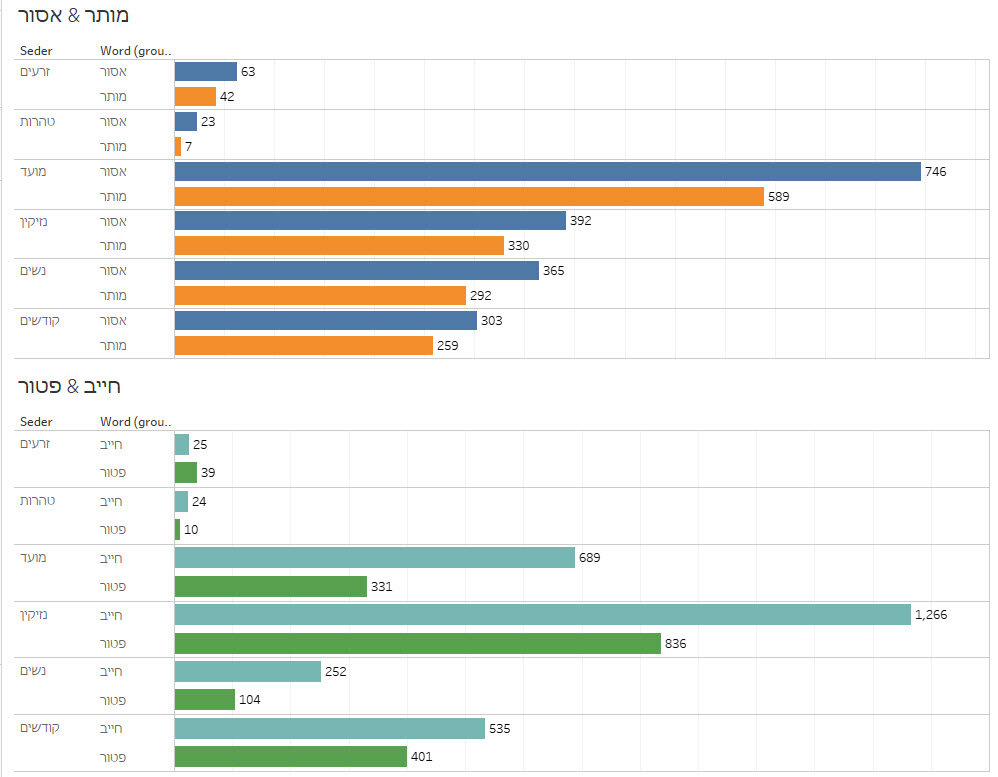Some 62 days ago we began a new cycle of learning with the opening of the very first tractate of the Talmud, called Berachot. At that time we discussed how many words there are in the Babylonian Talmud. As you may recall, thanks to our friends at Sefaria, the answer was 1,860,131.
Tomorrow we will close the study of Berachot, and as a parting gift we share the wonderful work of Moshe Margulies of Silver Spring Maryland. I was lucky enough to hear Moshe present his findings at a local Siyyum Hashas in early January, and he kindly agreed to share them with you, our dear Talmudology reader. His question was this: What are the most common words and names in our beloved Babylonian Talmud?
First some methodology: He downloaded the PDF files of every tractate of the Talmud from here. Then he used a word count generator, (but only looked at the top 2500 words in each tractate.) And finally, he copied the counts into Excel, and performed the analysis in Tableau.
The most common word in the Talmud is…
“He said”. אמר. Of course it is. Because the Talmud is a written record of centuries of oral debate. Mostly by men (hence the “he said”), but sometimes by women. Here are the top 50 word frequencies in the Babylonian Talmud. It is interesting to learn though, of the second most frequent word: “No.” More on that later.
As Moshe pointed out, what is is striking is the big the gap is between the most frequent word, which is mentioned more than 35,000 times and the 25th word, which is mentioned a mere 6,000 times. “Without knowing anything about the Gemera, this tells us what it is focused on. Telling us things. Saying over what other people have said. Tradition.”
And the most common name is…
“Rav” and “Rebbi” are at the top, which isn’t much of a surprise, since they are both the monikers of two specific talmudic rabbis, and are also used as a general honorific, much like Professor is used within universities. But Yehuda wins the award for being the most frequently mentioned name.
Rava and Abaya are two of the most commonly cited pair of rabbis who sparred against each other. Although they always seem to be mentioned together, this analysis discovered that Rava is the 5th most common name and Abaya is the 9th most common name. Weird, no?
Also note the gap between the top name, Rav – which is listed nearly 18,000 times, and fifteenth placed Yosef – which is listed a mere 1,900 times.
Continuing with the theme of famous sparring rabbis, Shamai is listed nearly 40% more times than Hillel, even though the Talmud almost always rules in favor of Hillel. Who knew?
The Longest word in the Talmud
Can you guess? It is….מדאורייתא “from the Torah.” At least it is the longest of any word that appears in the top 2500 most common words. Please let us know if you find a longer one.
Which is more likely? Permitted or forbidden?
We will end this fascinating analysis with this question: is the Talmud more likely to “permit” or to “forbid”? The answer seems to vary by tractate and which precise word you are using, but overall assur - “forbidden” beats mutar - “permitted” and is listed 300 more times.
You can find the dataset and results of Moshe’s analysis at Tableau, where you can also do an analysis of your own. In fact, if you are sitting alone with nothing to do in quarantine, this might be a useful way to pass the time.
Shabbat Shalom, and Stay Safe, from Talmudology.




